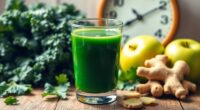Prune juice has a sweet, slightly tart flavor that can be pretty distinctive. You might find it rich and complex, but some people think the sweetness is overwhelming. If you prefer lighter juices, prune juice could be challenging for you. However, many enjoy the balance of sweet and tart. Mixing it with stronger juices like cranberry or citrus can enhance the experience, making it more enjoyable. Discovering flavor combinations can make your juice journey even more interesting.
Key Takeaways
- Prune juice has a sweet and slightly tart flavor, with natural sugars contributing to its taste profile.
- The sweetness can be overwhelming for some, leading to strong aversions among those who prefer lighter juices.
- A lingering tart aftertaste adds a unique twist, enhancing the overall flavor experience.
- Mixing prune juice with stronger juices like cranberry or citrus can create a more balanced and enjoyable drink.
- Despite its distinct taste, prune juice offers health benefits that can be appreciated when blended with other flavors.

When you take a sip of prune juice, you're met with a flavor that's both sweet and slightly tart, thanks to the natural sugars in pure prunes. This intriguing flavor profile often evokes a strong reaction. On one hand, you might appreciate the refreshing aspect of the juice, while on the other, the overpowering sweetness can leave you feeling conflicted. For some, the taste is enjoyable, but many find it veering into the unpleasant territory, often recalling descriptions like "nasty" or even likening it to "blood." It's clear that prune juice isn't for everyone.
As you delve deeper into the experience, you might find that the sweetness is almost overwhelming. The natural sugars contribute a rich taste that can be delightful in moderation, but when consumed in larger quantities, it can quickly become cloying. The slightly tart aftertaste that lingers on your palate can add a unique twist, but it may also be the tipping point for those who struggle with the overall flavor.
For people who prefer their juice on the lighter side, prune juice can present a challenge, and it's no wonder that some individuals develop a strong aversion to its distinct taste.
Interestingly, while the majority may shy away from prune juice, a minority genuinely enjoys its flavor. They appreciate the sweet and tart balance, finding comfort in this unique juice. If you happen to be among those who like it, you're in a small but devoted group. However, if you're part of the larger crowd that doesn't enjoy it, you're not alone. Many people would rather choose stronger fruit juices, like cranberry or citrus, which are generally more palatable and can easily be mixed with prune juice.
This blending can help mask the overpowering sweetness and make drinking it a more enjoyable experience. If you’re curious about how to make prune juice more appealing, experimenting with different combinations might be the answer. Mixing it with other strong fruit juices can create a more balanced and enjoyable drink. Additionally, you might consider adding a splash of citrus, such as lemon or lime, to enhance the flavor and provide a refreshing contrast. For those wondering how to make prune juice more palatable, incorporating a hint of ginger or a touch of honey can further elevate the taste. With these simple adjustments, you can transform your beverage into a delightful and nutritious option.
You could consider adding cranberry juice, which brings its own tartness and complexity, or citrus juices that add a bright, zesty flavor. By doing so, you can still reap the benefits of prune juice without feeling overwhelmed by its unique taste.
Frequently Asked Questions
What Does Prune Juice Taste Like?
When you try prune juice, you'll notice its sweet and slightly tart flavor.
Some might describe it as rich and robust, reminiscent of overripe fruits.
However, you could find that its concentrated sweetness is overwhelming, with an earthy quality that may not appeal to everyone.
If you're not a fan of bold flavors, you might want to mix it with other juices to make it more palatable and enjoyable.
How to Hide the Taste of Prune Juice?
If you’re looking to hide the taste of prune juice, try mixing it with stronger fruit juices like cranberry or pineapple. Additionally, adding a splash of lemon or lime juice can provide a refreshing tang that balances out the natural sweetness of the prune juice. If you’re interested in more tips for enhancing prune juice flavor, consider blending in some fresh or frozen fruit, such as bananas or berries, which can create a delicious smoothie-like consistency. Experimenting with these combinations can make your drink more enjoyable while still reaping the health benefits of prune juice.
Adding a splash of lemon or lime can neutralize its sweetness, making it more enjoyable.
You can also blend it with apple or orange juice for a tasty combo.
Incorporating yogurt or milk creates a creamy smoothie, while adding other fruits or nut butter enhances flavor and nutrition.
Experiment and find what works for you!
What Is the Best Way to Drink Prune Juice?
To truly enjoy prune juice, try mixing it with your favorite fruit juices like cranberry or orange.
You'll find that blending flavors can make it more enjoyable. If you prefer a chill, drink it straight from the fridge for a refreshing experience.
You can also toss it into smoothies for added sweetness and fiber.
And for a lighter option, consider PlumSmart Light to maintain those digestive benefits while enjoying a fresher taste.
How Long After Prune Juice Will I Poop?
After you drink prune juice, you can expect to have a bowel movement within 1-3 hours.
It typically works quickly due to its sorbitol content, which draws water into your colon, making it easier to go.
If you're looking for overnight results, try having it before bed.
Keep in mind that everyone's body reacts differently, so the exact timing may vary for you.
Stay hydrated for the best results!
Conclusion
In conclusion, tasting prune juice is like embarking on a journey through deep, rich flavors. Its sweetness dances on your palate while earthy undertones ground it, creating a unique experience. While some may find it an acquired taste, many appreciate its robust profile and health benefits. So, whether you sip it straight or mix it into smoothies, prune juice offers a distinctive flavor that can surprise you and leave a lasting impression.
Cindy thoroughly researches juicing trends, techniques, and recipes to provide readers with practical advice and inspiration. Her writing style is accessible, engaging, and designed to make complex concepts easy to understand. Cindy’s dedication to promoting the advantages of juicing shines through her work, empowering readers to make positive changes in their lives through the simple act of juicing.

















